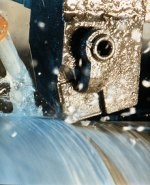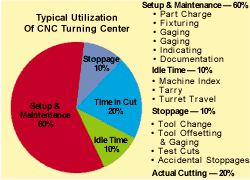The Case For Cutting Tool Standardization
It's possible to increase overall machining efficiency at the same time you decrease cutting tool inventory. Here's how.
Share





As your metalworking operation evolves, the jobs you perform change, as does the tooling you need to do the jobs. Most often, other priorities overshadow attempts to manage the evolution of your tooling systems. However, rationalizing your metalworking tooling will boost the productivity of your machining operations and add to your bottom line. While the details of these programs vary from shop to shop according to size and production requirements, the ultimate goal is the same: to lower the unit cost of each part that goes out the door.
The path to lower unit cost and increased profitability has three basic steps:
- Consolidation of your supplier base by unifying your buying power, centralizing your purchasing, and gaining value-added services through alliances with your suppliers.
- Standardization of your tooling inventory by adopting standards, removing obsolete tools, and maintaining ongoing control.
- Optimization of your machining operations by process and material to increase output without raising manufacturing costs.
Supplier Consolidation—Unified Buying Boosts Benefits
Years ago, a small shop might spend $10,000 a year on tooling and related items for manufacturing support. Today the same shop probably spends five times as much. Even considering inflation, tooling suppliers today do not consider a $50,000 account "small." But a shop owner who spreads his purchases among a number of suppliers may well appear to be a small account in the eyes of his suppliers.
The shop owner should realize that by consolidating his purchasing among fewer suppliers he can boost his buying power and gain other benefits by forming alliances with the remaining key vendors. The reason is that, in the interest of efficiency, tooling suppliers service their accounts based on sales volume, not potential. So the "small" shop may be handled by telemarketing while medium size operations are serviced by distributors. The larger accounts, on the other hand, are handled by direct sales contacts who supply technological support and other major programs aimed at helping larger customers lower unit costs, increase profits, and grow even larger.
In order to place yourself in this category, you should consolidate your suppliers, unify your buying power, and thereby receive all of the benefits your actual volume warrants.
The concept of supplier consolidation goes hand in hand with the trend towards "integrated supply." Integrated supply programs can be a big help in leveraging your buying power, but they usually aren't designed to provide full standardization and optimization services. In most cases, integrated suppliers replenish product and manage existing inventory, but have limited capability to provide new technology while removing items that the new technology replaces. Also, what an integrated supplier may consider "obsolete" for the industry as a whole may in fact be the best tool for a specific job in your particular shop.
Inventory Standardization—Less Is More
The basic premise of standardization is consolidating and maintaining tooling inventory levels while continuing to take advantage of all relevant new technologies. This "put-and-take" system sees that obsolete tools are removed when new tooling is added.
Many manufacturers have ignored the idea of analyzing and reducing tooling inventory. In a plant that hasn't done any kind of standardization we typically find a year's worth of inventory in the crib, on the floor, under benches and in toolboxes. On any given day, it's not uncommon to find that as much as 65 to 70 percent of tooling inventory can be identified as redundant or obsolete. To verify this for yourself, pick a single style of insert that's commonly used in your shop and add up all the versions of the tool from different manufacturers that you currently have on hand.
The negative impact of excess tooling inventory can extend beyond increased carrying and storing costs. For example, if you haven't eliminated obsolete tooling, you may go to the tool crib to get an item and, if it's not there because your replenishment is not well managed, you substitute with something that's been unused for ten years. Then whatever replenishment system you do have may perpetuate a previously obsolete technology that now appears to be active.
The good news is that, while removing the obsolete tooling, it is quite possible to provide an average 30 percent increase in productivity or throughput by introducing new technology or by leveraging productive existing technology that hadn't been as broadly applied across the shop as it could be.
Overall tooling expenses will probably go up with standardization, as use of total machining capabilities—for example, up to 80 percent of available machine horsepower—produces productivity enhancements. However, cost per manufactured unit and lead times will go down to an even greater degree.
Cleaning Out The Garage
Today it's impossible to just start a put-and-take system in an existing operation and get good tool control. Manual intervention to eliminate obsolete tooling has to come first.
Manual intervention involves determining in detail what tooling you're using, what you are not using, and what new tools are available. If you put something new in, it probably replaces something else and you have to make sure you take the obsolete tooling out. So it's a process that has to be communicated, learned and managed. It simply involves a lot of hard work.
For inserts, holders, milling cutters and so on, the basic process is simple. Start by studying your tooling inventory. List quantity on hand, quantity used during the last 12 months and, if possible, where used. If an item hasn't been used in 12 months, or if it's a special item that can be replaced with a standard catalog item, for your purposes it is obsolete.
Consolidate the remaining tools. Group similar insert sizes, shapes and nose radii, and eliminate as many of the low-usage items as possible to take advantage of quantity price breaks. Then you can tie this standardization process to the materials you're machining and operations being performed.
Consolidation also can open the door for the use of high-performance, wide-application cutting tool grades. Replacing a variety of traditional grades with premium grades can result in price breaks that make the cost of the premium grades comparable. Versatile insert geometries, such as the 80-degree diamond, also can enable you to replace a variety of tools and further increase efficiency.
A Little Help
Physically getting control of your tooling inventory is tedious, but it works. It is possible for shops to consolidate tooling inventory by themselves, but it requires a huge amount of time and expertise, so it may be more practical to work with an outside consultant. Whoever implements the program must overcome the shop's prejudices and any prejudices of his own.
If you have consolidated your buying power and have a solid partnership with your tooling supplier, you can take advantage of the supplier's expertise and objective viewpoint to help you review your tooling needs and adjust your inventory.
Nobody knows your shop better than you do, but an outside consultant can help assure success. An oversimplified but clear analogy for the need for outside help compares a standardization program to cleaning out your own garage. You take everything off the shelves and off the floor and put it in the driveway. Then you sweep and hose the place out. Then you start to put things back on the shelves. You might need this, you never know...you used to use this a lot...here's that bowling ball you rolled a 200 with 15 years ago...that sled we used to use in New England before we moved down south 10 years ago...and soon enough you have all the same stuff back in the garage.
Using an outside consultant to standardize your tools is like having your neighbor come over and help you clean your garage. Your neighbor will ask questions like: "What do you keep that for? Do you really need that? When was the last time you used that?
You may even be able to recoup some of your investment in the obsolete tools you find. Many vocational schools still used brazed tools, for example, and would be happy to accept a donation of your technologically obsolete inventory. Check with your tax advisor, certainly, but you may be able to write off some or all of the purchase price of the tools you donate and perhaps even some if the carrying charges. So you can invest in the future at the same time that you throw out the past.
Use The Right Systems
Information technology has been developed to help you manage your tooling inventory. These software packages are not simply purchasing programs but are actual tool management systems.
Many companies use internal systems that were designed to manage tooling from the perspective of inventory replenishment and procurement, but don't really address put-and-take concepts at the level of the tool engineer. True tool management systems are designed to control your inventory in the tool crib and out on the shop floor with the people that use the product. Kennametal's Tool Location Management software, for example, enables users to report all tools charged to a given job, employee or location, and to easily record inventory changes as tools are withdrawn, returned, reworked or scrapped. The system automatically reports tool shortages when a prescribed minimum stocking level is reached. This and similar systems can be custom-modified and expanded to fit the precise needs of a specific shop.
Machining Optimization—Focus On The Process
A basic way to increase manufacturing volume without increasing costs is to optimize machining operations for maximum productivity. But most shops can't afford to dedicate a process engineer to optimizing every individual operation. With the exception of high-volume, high-capitalization situations like automotive manufacturing, shop personnel time is best spent making parts and troubleshooting, not optimizing specific operations.
To increase productivity without individually analyzing every operation, you can optimize your whole shop at once in terms of processes (turning, milling, drilling, grooving and so on) and workpiece materials. For example, you can choose an insert grade and geometry to use in all your ductile iron turning applications. While this approach may not give you the greatest possible productivity 100 percent of the time, it will combine significant productivity increases overall with the additional benefits of simplification and time savings through shop floor understanding and application.
Although it may sound odd, the best-performing tool for a specific process and workpiece material may not be the best tool for your job. It's proven that a $200 cubic-boron-nitride insert will turn gray iron at high speeds with extended tool life. But using a tool that will cut 10,000 pieces on a 50-piece job you only run once a year is not the best use of your resources. A $10 alumina-coated general-purpose carbide insert might be "best" for the job, and should also have application elsewhere in your shop. In a medium-to-small size operation, across-the-board application of high technology is not always the answer. And in many cases, older equipment won't run at the speeds and feeds required by today's more sophisticated tooling technology.
Standardizing through functionality and materials also prepares you for the products you will make in the future, because it is based on process (turn, mill, drill) rather than on individual operations alone.
Seek Real Savings
While you are optimizing your machining operations by process and materials, you have to consider the whole floor-to-floor progress of your part. In a small to medium size shop, only about 20 percent of manufacturing time is spent actually cutting. The other 80 percent of the time is spent in setup, loading and unloading parts, maintenance, gauging, idle and stoppage time, and anything else other than actually making chips.
If you optimize only the actual cutting operation, a move to a high-tech insert might give you a 20-percent reduction in cutting time, but that is still just 4 percent of the overall time needed to manufacture your part. Productivity increases of this size are rarely worth the time, effort and training involved.
On the other hand, analysis and optimization of other steps in the machining process can produce significant savings. Quick-change tooling can cut setup and maintenance time in half. Savings on this order can justify the cost of major tooling support systems.
While optimizing an entire shop by process and material is the best approach for most shops, there are exceptions to the rule. Many shops have one or more high-production jobs that run frequently and provide a solid, reliable flow of revenue. While you're optimizing your whole shop and performing your daily fire fighting chores on acute problems, don't neglect those high production jobs—your "cash cows."
For these high-volume operations, advanced technology can provide incremental improvements that multiply over the long production haul. This is where a high-tech insert grade, a turret loaded with duplicate quick-change tools to slash downtime, or perhaps part load/unload automation can produce significant long-term reductions in unit cost.
But as you seek to boost the productivity of single operation, remember that a manufacturing process is only as fast as its slowest step. You may fine-tune a machining center operation to put out 50 parts an hour only to find that they sit on the floor next to the grinder that can process just 25 parts an hour. Always find and optimize your bottlenecks first and then modify other processes and purchase tooling accordingly. Optimizing a given function should be based on the entire picture.
Commitment Is The Key
The concepts of standardization, optimization, and tool management all sound wonderful, but none will work unless management puts its support behind the program. If there's no company-wide commitment to standardization, it won't be successful. With top-level support, it can happen.
Commitment is important to the ongoing success of the program. Once you establish the process, train your people and cull obsolete inventory, the program becomes an ongoing management process. You straighten things out once, but then the system must be managed thereafter.
Even a brand new startup facility needs a commitment to tool management. If the mental process isn't there, if the focus isn't on some of these details, if someone doesn't have time-dated accountability for it, you may have to go back into a new plant and begin a consolidation process.
Successful standardization is a combination of commitment, planning, training, communication, cooperation and hard work. Remember, it took time to evolve to where you are. Time and effort will be necessary to increase throughput, lower unit costs, and reduce the number of items in your inventory. And like anything worthwhile, the results will exceed the effort.
Related Content
Shoulder Milling Cuts Racing Part's Cycle Time By Over 50%
Pairing a shoulder mill with a five-axis machine has cut costs and cycle times for one of TTI Machine’s parts, enabling it to support a niche racing community.
Read MoreQuick-Change Tool Heads Reduce Setup on Swiss-Type Turning Centers
This new quick-change tooling system enables shops to get more production from their Swiss turning centers through reduced tool setup time and matches the performance of a solid tool.
Read MoreCustom PCD Tools Extend Shop’s Tool Life Upward of Ten Times
Adopting PCD tooling has extended FT Precision’s tool life from days to months — and the test drill is still going strong.
Read MoreHow to Mitigate Chatter to Boost Machining Rates
There are usually better solutions to chatter than just reducing the feed rate. Through vibration analysis, the chatter problem can be solved, enabling much higher metal removal rates, better quality and longer tool life.
Read MoreRead Next
5 Rules of Thumb for Buying CNC Machine Tools
Use these tips to carefully plan your machine tool purchases and to avoid regretting your decision later.
Read MoreBuilding Out a Foundation for Student Machinists
Autodesk and Haas have teamed up to produce an introductory course for students that covers the basics of CAD, CAM and CNC while providing them with a portfolio part.
Read MoreRegistration Now Open for the Precision Machining Technology Show (PMTS) 2025
The precision machining industry’s premier event returns to Cleveland, OH, April 1-3.
Read More


















.png;maxWidth=300;quality=90)













